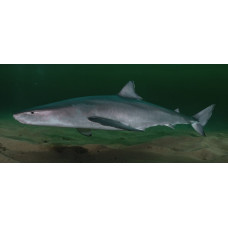Latin name
Squalus altipinnis
Other name
Squalus altipinnis
Identification
The distance from the tip of the snout to the second dorsal fin is 4.3-4.4 times the length of the anterior edge of the pectoral fin and 3.1 times the length of the caudal edge of that fin. The length of the head is 4.4-4.7 times the length of the eye. The number of vertebrae is 114-120. The nostrils are framed by short flaps of skin. The upper and lower teeth are interlocked to form a single blade-like cutting surface. There are long, protruding spines at the base of the dorsal fins.
Features of fish fins
The anal fin is absent. The first dorsal fin of these sharks is erect. The pectoral fins of adult sharks are not crescent-shaped. There are long spines at the base of the dorsal fins. The base of the second dorsal fin is broad.
Fish colouring
The colouration of the Western highfin spurdog is dark grey. The dorsal surface is dark and sharply demarcated from the lighter ventral surface on the side of the head. The spine of the first dorsal fin is noticeably lighter than the base of the soft part of the dorsal fin.
Distribution
The Western Highfin Spurdog is found in the eastern Indian Ocean, off the west coast of Australia.
Habitat
Tropical marine pelagic-oceanic species. These sharks are found on the continental slope at depths of 298 to 305 metres.
Size
The maximum recorded size of this species is 58.9 cm.
Behavior
The long and slender body of this fish allows it to part the water with ease and swim at great speed.
Food and feeding habits
The diet of the Western highfin spurdog is varied. It consists of bony fish such as mackerel, gudgeon, hake, haddock, pollock, Atlantic salmon, flounder, as well as crabs, squid, shrimp, cephalopods, polychaetes, sea anemones, jellyfish and even algae. Despite their small size, the jaw and tooth structure of these sharks allows them to deliver powerful bites.
Reproduction
This shark species reproduces by oviparity, with fertilisation occurring internally. Mating takes place in spring. The developing eggs are located in the dilated oviducts and are arranged in two thin gelatinous capsules. Each capsule contains between 3 and 13 eggs (usually 1-4). Development of the embryos in the female takes 18-22 months. The young are usually born in spring, but sometimes hatching extends into autumn. There are between 6 and 29 young in a litter.
Fishing
The species is of no interest to commercial fisheries. Sometimes caught as by-catch in fishing nets.
Relationship with a person
Western highfin spurdog sharks are not dangerous. A person can only be injured by barbs or fin rays if the catch is handled carelessly, as captured sharks are capable of bending strongly. Glands at the base of the spines produce a weak venom.
| Classification | |
| Phylum | Chordata |
| Class | Chondrichthyes |
| Squad | Squaliformes |
| Family | Squalidae |
| Genus | Squalus |
| Species | S. altipinnis |
| Features | |
| Conservation status | Data Deficient |
| Habitat | Pelagic |
| Life span, years | No information |
| Maximum body weight, kg | No information |
| Maximum length, cm | 58,9 |
| Sailing speed, m/s | No information |
| Threat to people | Edible |
| Way of eating | Predator |
Western highfin spurdog
Tags: western highfin spurdog

